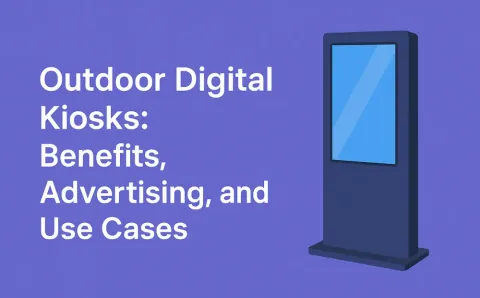Outdoor kiosks. You’ve seen them. Maybe outside a store. Maybe in the middle of a plaza. Maybe at an event when you were trying to find your way. And maybe, for a second, you thought, Should we be using one of those?
Outdoor kiosks aren’t new, but their use is changing fast because they offer a solution to increasing visibility, engagement, information flow, and reach in high-traffic outdoor spaces.
In this blog, I’ll tell you what an outdoor digital kiosk actually does, who it’s for, and what you need to know before deciding to invest in one.
What Are Outdoor Digital Kiosks?
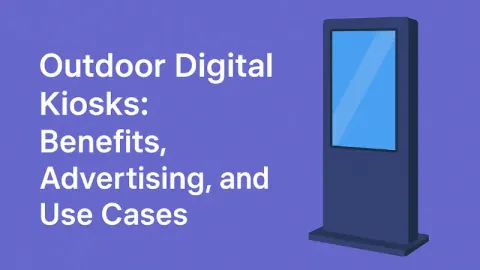
Outdoor digital kiosks are standalone screens designed for public spaces. You’ll find them outside shopping centers, on busy streets, at transportation hubs, in parks, or at large outdoor events. They serve one main purpose: to communicate with people in real-time, where they already are.
These kiosks are designed to work outdoors, in places where people are moving, waiting, or gathering. For instance, you might see them outside stores, along walkways, at transit stations, or during big events.
They’re mainly used to display important information, such as ads, directions, updates, or other helpful content.
Most interactive outdoor kiosks serve either or all of the following functions:
- Advertising: These kiosks display dynamic, eye-catching ads that can be updated in real time.
- Information sharing: From maps and schedules to safety alerts and event guides, they help people navigate and stay informed.
- Interactive engagement: Enabling users to search, browse, scan, or respond via touchscreen input.
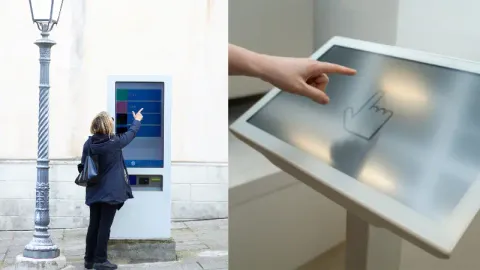
Behind the scenes, these kiosks are built on a combination of durable hardware and flexible software:
- Touchscreen displays are designed for outdoor readability and public use.
- Digital signage software that lets businesses and organizations control content remotely.
- Weatherproof and tamper-resistant enclosures that protect the technology inside and reduce maintenance needs.
Practically speaking, digital outdoor kiosks are tools for communication. For some businesses, they function as always-on advertising kiosks in high-traffic locations.
For others, they’re a way to streamline information flow, support on-site engagement, or extend services beyond the front door.
Types of Outdoor Digital Kiosks
All outdoor kiosk types solve a different problem, and choosing the right one depends on your goals.
Below are the most common types of outdoor kiosk solutions, each designed for a specific function in public or high-traffic environments.
1. Interactive Kiosks

These are self-service kiosks people walk up to and actually use (not just look at). They might use it to search for store information, browse a menu, make a payment, or scan a QR code.
These interactive digital outdoor screens are built for real-time engagement. They’re common outside shopping malls, quick-service restaurants, transit stops, and tourism hubs.
They combine digital kiosk displays with touchscreen technology and even integrate payment modules, cameras, or scanning tools.
2. Wayfinding Kiosks

Wayfinding kiosks are built to help people get from point A to point B, especially in large or complex outdoor spaces like open-air shopping centers, parks, airports, or city centers.
Most use a combination of interactive maps, directories, and route-planning tools to guide users. What makes them valuable is their context-awareness.
Good wayfinding kiosks adjust based on location and even time of day. They also contribute to smoother crowd flow and reduce reliance on staff.
3. Advertising Kiosks
These kiosks are built for visibility and volume. Businesses usually place them in high-traffic areas where there’s constant footfall. The sole purpose of an advertising kiosk is to display dynamic branded content.
You can schedule what they show, switch out content on the fly, and even pull in live updates, like the current weather or traffic.

4. Smart Kiosks
Smart kiosks are the next step up from the typical screen-and-touch setup. They often have advanced features, like sensors, cameras, or even AI, that let them respond to their surroundings.
How Outdoor Kiosks Are Changing Advertising
For a long time, outdoor advertising meant one thing: fixed messages on static surfaces, i.e., billboards, posters, and banners. You printed once, hoped it landed, and waited. But that model doesn’t reflect how people move, think, or respond anymore.
The kiosk ad is a more flexible, responsive way to meet people where they are, with content that’s timely and alive.

Traditional billboards will stay the same for weeks. But a digital kiosk? It can change its content several times a day. You can change ads based on time, weather, or even the type of event happening nearby.
This kind of real-time control is what makes outdoor advertising solutions built around kiosks so impressive. Advertisers aren’t stuck with a one-size-fits-all message. Instead, they can shift, test, and adapt depending on what’s happening on the ground.
A lot of kiosk systems also track what’s happening around them. So you can see how many people walked by, how long they stuck around, and what kind of content actually got their attention.
Compare that to a static billboard, where the only metric is foot traffic estimates, and suddenly, the value of a kiosk ad becomes pretty clear.
What we’re seeing is a shift from passive to active. Kiosks are becoming part of how businesses speak to people in public spaces.
Benefits of Outdoor Digital Kiosks for Businesses
Honestly, most people don’t care about the tech. They care if it works. And for a lot of businesses, outdoor kiosks are starting to make a real difference because they’re useful.

Have a look at some of its major benefits:
24/7 Visibility
You can only keep your doors open for so many hours a day. A kiosk doesn’t have that problem. Whether it’s 2 PM or 2 AM, it’s still showing your latest offer, directions, or whatever you need people to see. It works even when you’re not there.
Eco-Friendly
We’ve all been there: new promotion, new poster. Wrong price, new print. Weather ruins it? Print again. With digital signage, you make the change once, and it’s live. No paper, no reprints, no waiting. Just updated info when you need it.
Customer Engagement and Insights
Many kiosks include interactive features that invite people to interact. This enables options like collecting feedback, capturing leads, guiding customers, or even running loyalty campaigns.
High Degree of Customization
What you show in the morning might not make sense by afternoon. Maybe it’s raining and you want to promote umbrellas. Maybe the lunch rush is over, and you want to push coffee. Outdoor kiosks let you change your content as often as you need.
Where Can You Place Outdoor Digital Kiosks?
There’s no one right place to put an outdoor kiosk. It really depends on who you’re trying to reach and what you want them to do. But over time, a few locations have proven to work well, i.e., places where people naturally stop, wait, or look around.
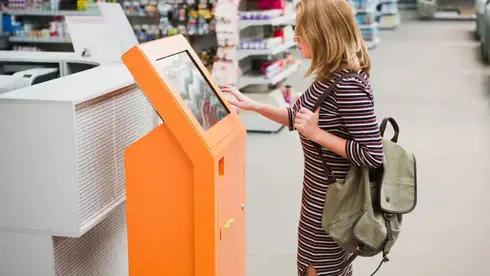
Public Spaces
You’ll find kiosks in places with lots of activity, such as airports, train stations, bus stops, malls, and parks.
These are the spots where people are usually waiting, looking around, or trying to figure something out.
If a kiosk is placed well, it can show directions, give updates, or just display something useful enough that people stop and look.
Retail Locations
Outdoor shopping areas, storefronts, and even store entrances are great spots. A kiosk outside your business can help bring people in, show promotions, or just answer common questions. Some retailers also use indoor kiosks or desktop all-in-one POS kiosks for product lookup, check-in, or ordering.
Urban Environments
In cities, kiosks are starting to become part of everyday infrastructure. Local governments and planning teams are using them to share transit updates, promote city services, help tourists get around, or even report local weather and emergencies.
Events and Exhibitions
Outdoor events, festivals, trade shows, and exhibitions are ideal for temporary kiosks. You can use them to guide visitors, promote schedules, collect feedback, or run time-limited offers.
How to Choose the Right Outdoor Digital Kiosk for Your Business
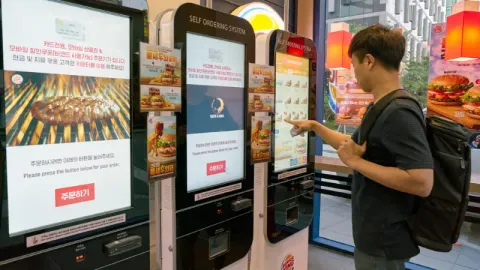
The hardest part about investing in an outdoor digital kiosk isn’t deciding if it’s useful. It’s figuring out which one actually fits your business.
Here are a few things you should consider:
Size and Placement
Where will you place it? This one question says a lot. A kiosk on a sidewalk needs to be slim and sturdy. Whereas, one in a wide-open plaza might need a bigger screen to stand out. Placement affects visibility, foot traffic, and even the kind of hardware you’ll need.
Software and Content Management
The screen is just one piece of the puzzle. You’ll want to look at what kind of software comes with it. Can you easily update your content from anywhere? Can you schedule what shows and when? If it’s not easy to manage, it’s going to sit idle.
Weather Resistance
If it’s going outside, it needs to be able to take a beating. Look for kiosks that are rated for outdoor use (IP-rated enclosures, anti-glare screens, good ventilation). This stuff matters more than it seems.
Cost

The cost of a kiosk matters. But instead of asking “What’s the cheapest option?”, ask “What’s going to last the longest and do what I need?” The cheapest kiosk might not include the software you need or might fall apart after a year. Sometimes spending a bit more upfront saves you a lot later.
Compare Providers
Not all kiosk companies offer the same support, hardware, or flexibility. Some specialize in retail, others in events, or public sector projects. Look at case studies. Ask questions. And make sure you know what’s included.
Think About Your Industry
A kiosk for a clothing store looks very different from one used at a music festival. Retail kiosks might need barcode scanners, payment options, or loyalty integrations. Event kiosks might just need a big, clear touchscreen and easy navigation.
The Future of Outdoor Digital Kiosks
Outdoor digital kiosks have already come a long way from being just screens with basic information. And the truth is, we’re still at the beginning of what they’re capable of.
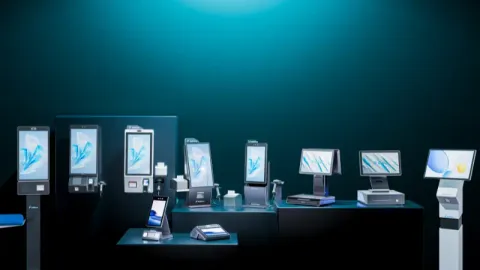
Smart Kiosks
With AI and machine learning now in the mix, digital outdoor kiosks are becoming smarter by the day. Instead of simply displaying ads or directions, they can learn from the people interacting with them.
Smart AI kiosks even have the potential to overcome societal challenges such as homelessness.
AR and Interactive Experiences
Augmented reality (AR) is starting to emerge, too. Imagine pointing your phone at a kiosk and seeing a 3D product demo or trying on a pair of virtual sunglasses. These ideas are already being tested and used in some forward-thinking cities and brands.
Real-Time Data Through IoT
The future also lies in how kiosks connect with other devices. Thanks to the Internet of Things (IoT), outdoor digital kiosks can pull in real-time data and use it to make smarter decisions.
Of course, there are still challenges to figure out. Privacy is a big one. As kiosks collect more data, businesses will need to be transparent about what’s being gathered and how it’s being used.
There’s also the cost factor. High-quality kiosks with advanced tech are not cheap upfront, and they need regular upkeep to stay running smoothly. But one thing’s for sure, it surely offers a lot of room for businesses to grow.
FAQs
What are the benefits of outdoor digital kiosks?
They give your business 24/7 visibility, let you update content in real time, and help you engage with people where they already are.
How do outdoor kiosks work for advertising?
Outdoor kiosks can run targeted ad campaigns that change based on time, location, or audience behavior. They’re great for rotating content, promoting specials, or sharing updates instantly.
Can I use an outdoor kiosk for customer engagement?
Yes, especially if it’s interactive. People can tap to find info, get directions, make purchases, or even sign up for offers.
Conclusion
If you’ve made it this far, you’re probably not just curious about outdoor digital kiosks. You’re seriously considering how they might work for your business.
And honestly, that’s the right question to ask. Because these kiosks are not a fancy investment, they’re a way to stay visible, share useful information, and interact with your customers.
If you’re ready to see how digital kiosks can transform your business, let’s dive in and explore the possibilities.
Ready to bring your business into the future with smart kiosk solutions?
Discover SwiftForce’s kiosk solutions here. Contact us today to see how we can help you build a customized solution for your needs.

